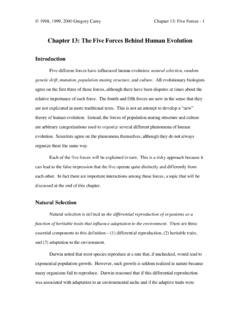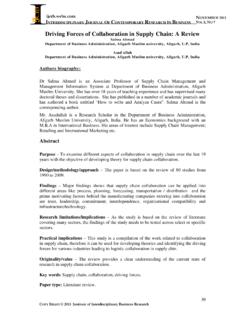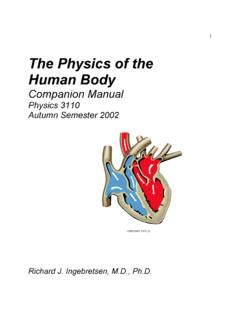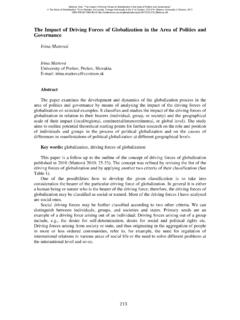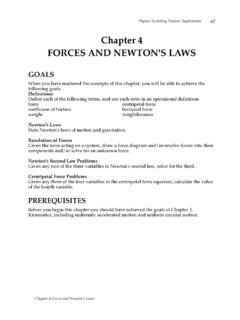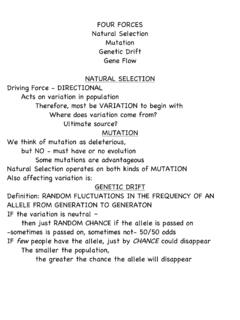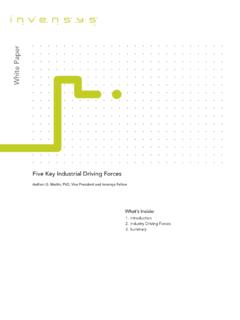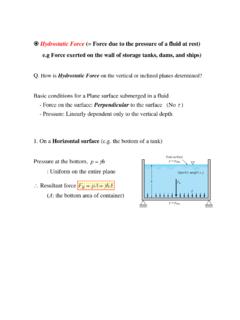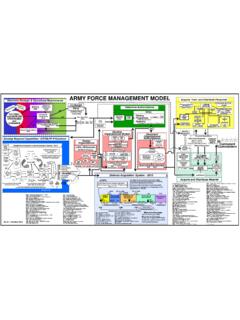Transcription of Chapter 20
1 Driving Forces AnalysisChapter 20FT Press 2007. All Rights and Competitive Analysis. By C. Fleisher & B. Driving Forces Short Description Background Strategic Rationale & Implications Strengths & Advantages Weaknesses & Limitations Process for Applying Technique Summary Case Study: Digital Music Industry FAROUTFT Press 2007. All Rights and Competitive Analysis. By C. Fleisher & B. Description Driving forces analysis (DFA) is a way of understanding and accounting for change at the industry level. Drivers are clusters of trends that create influences on changes to an industry s structure and a rival s competitive Driving ForcesFT Press 2007. All Rights and Competitive Analysis. By C. Fleisher & B. DFA was developed in the 1950s as a means for helping organizations and individuals deal with changes in the business environment.
2 FFA was used to analyze the conditions that support or restrain a given outcome. This work captured the fancy of economists and set the stage for the further development of DFA within the competitive industrial context. Forces that push toward change are called driving forces. Forces that resist change are called restraining forces. DFs are those significant, underlying currents that define and drive events and trends in certain directions. These forces are typically broad in scope, long term in nature and associated with Driving ForcesFT Press 2007. All Rights and Competitive Analysis. By C. Fleisher & B. Rationale and Implications Industry conditions change because forces are driving industry participants to alter their actions. DFs originate from within a firm s industry and can create uncertainty.
3 First task: look for the DFs of the macro-environment. DFs may seem obvious to one person but be hidden to another. Should be done in a team environment. Firms have little control over DFs ability to deal with them comes from recognizing and understanding their effect. DFA plays a critical role in the larger strategy development process. Ch20. Driving ForcesFT Press 2007. All Rights and Competitive Analysis. By C. Fleisher & B. and Advantages DFA is an essential component of several other analytical techniques. (environment/ industry) DFs by nature imply change. DFA receives a higher than average degree of managerial agreement. DFA can be done in a less data-intense fashion than many other techniques. Doesn t necessarily require the firm to gather data on a continual basis.
4 Ch20. Driving ForcesFT Press 2007. All Rights and Competitive Analysis. By C. Fleisher & B. and Limitations DFA cannot drive strategy formulation alone. Seldom answers specific strategy questions. DFs tend to be outside the control of any single firm. DFA nearly always needs to be inclusive and participative. DF analysis can suffer from many of the common internal, organizational biases when they are generated using only internal personnel. Ch20. Driving ForcesFT Press 2007. All Rights and Competitive Analysis. By C. Fleisher & B. for Applying the Technique There are two steps involved in performing DFA. The primary analytical task in performing DFA is to:1. Identify the relevant DFs. Separate the major causes of industry change from less important Assess the impact they will have on the industry.
5 This involves identifying the small number of DFs that are likely to have greatest impact on the Driving ForcesFT Press 2007. All Rights and Competitive Analysis. By C. Fleisher & B. for Applying the Technique Step 1:Identifying an industry s DFs. Some DFs are unique and specific to a particular industry s situation. Most DFs cut across business environment. They are usually identified by trends, or combinations of trends that combine to create a force . Some of the more common DFs across various industries are shown on next slide. Only look at those that are relevant to own industry. Are there any not on the list that apply to your industry?Ch20. Driving ForcesFT Press 2007. All Rights and Competitive Analysis. By C. Fleisher & B. for Applying the Technique Changes in long term industry growth rate.
6 Changes in who buys the product and how it is used. Changing societal concerns, attitudes, and lifestyles. Diffusion of expertise across more firms and locations. Election trends, government decisions and/or shifting regulatoryinfluences. Growing use of the internet and its applications. Important firms that enter or exit the industry. Increasing globalization of the industry. Innovation in communication and marketing. Innovation in processes and products. Changes in the long term industry growth rate. Major changes in customer needs and preferences. Major changes in production costs and efficiencies. Prominent changes in uncertainty and business risk. Technological change and manufacturing process Driving ForcesFT Press 2007. All Rights and Competitive Analysis. By C. Fleisher & B. for Applying the Technique Another way of trying to understand DFs is to understand how trends, (that is, ) or events ( ) relate to one another and a potential driving force :T7T1T2E1T4T5T8T6 Driving ForceE2Ch20.
7 Driving ForcesFT Press 2007. All Rights and Competitive Analysis. By C. Fleisher & B. for Applying Technique Completion of the first stage by a management group of a large, publicly funded University in Canada: Societal and demographic Increased diversity of students seeking university education. Question over the value of some credentials. Increasing desire by individuals for lifelong learning. Concerns over social inequities and fragmentation. Increasing complexity of social problems. Continuing aging of population in primary catchmentregions. Changing views regarding the appropriate role of Driving ForcesFT Press 2007. All Rights and Competitive Analysis. By C. Fleisher & B. for Applying Technique Economic Continued globalization. Growth increasingly powered by entrepreneurship.
8 Huge increases in participation rate of university students in some regions of the globe. Down turn of the economic cycle. Rising interest rates and impact on student loans. Political Uncertainties in public support for universities. Declining public funding. Increasing governmental demand for accountability. Increased student activism due to raised tuition Driving ForcesFT Press 2007. All Rights and Competitive Analysis. By C. Fleisher & B. for Applying Technique Technological Increasing demand for distance learning. Origination of new pedagogical platforms. Expanded use of IT. Escalating rates of innovation. Increasing value placed on knowledge. At the end of this step, the analyst should have a manageable list of DFs to consider. List should be in the range of five to 10 forces to facilitate the next step of this analysis Driving ForcesFT Press 2007.
9 All Rights and Competitive Analysis. By C. Fleisher & B. for Applying the Technique Step 2:Assessing the impact of the DFs The analyst s objective in this second step is to understand the external factors that will shape change in the industry. Once the DFs have been identified from Step 1, ask the following questions: Are they valid? How do we know? How significant are each of them? What is their strength? Which ones can be altered? Ch20. Driving ForcesFT Press 2007. All Rights and Competitive Analysis. By C. Fleisher & B. for Applying the Technique Questions Cont d: Which ones cannot be altered? Which ones can be altered quickly? Which ones can only be altered slowly? Which ones, if altered, would produce rapid change? Which ones would only produce slow change? What skills / information are needed and are available to change the forces?
10 Can you get the resources/capabilities needed to change them? There are three common approaches applied at this point. Ch20. Driving ForcesFT Press 2007. All Rights and Competitive Analysis. By C. Fleisher & B. for Applying the Technique Approach 1: Structured ranking approach. Considers all the DFs listed from Step 1 in pair-wise progression. Number of pair-wise comparisons grows rapidly with the number of DFs. Approach 2: Assign a score to each force , from 1 (weak) to 7 (strong). Calculate a total score for each force by adding across the two columns. Example on next Driving ForcesFT Press 2007. All Rights and Competitive Analysis. By C. Fleisher & B. to InfluenceTotal (rank) seeking more specialized after-sale services369 (5th) want higher fuel economy6511 (2ndtie) , safer, roads and highways allow for higher speeds235 (7th) demands for passenger safety448 (6th) technologies allow more engine and fuel options5611 (2ndtie) for product is increasing most in China and India for the product7512 (1st) options growing fast4610 (4th)Ch20.










